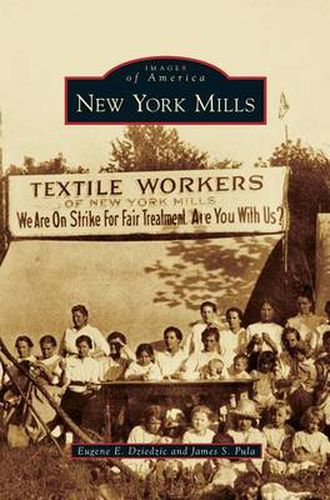Readings Newsletter
Become a Readings Member to make your shopping experience even easier.
Sign in or sign up for free!
You’re not far away from qualifying for FREE standard shipping within Australia
You’ve qualified for FREE standard shipping within Australia
The cart is loading…






This title is printed to order. This book may have been self-published. If so, we cannot guarantee the quality of the content. In the main most books will have gone through the editing process however some may not. We therefore suggest that you be aware of this before ordering this book. If in doubt check either the author or publisher’s details as we are unable to accept any returns unless they are faulty. Please contact us if you have any questions.
New York Mills, named for the textile factories that were once the backbone of the surrounding village’s economy, ranked among the foremost producers of quality fabrics in the country. Originally a wilderness area just south of the Mohawk River, the community began with a few scattered homes after the establishment of a small textile mill in 1808. Nourished by a growing economy, the village attracted a mosaic of Welsh and French-Canadian workers in the 19th century, followed by Poles, Syro-Lebanese, and Italians in the early 20th century. A hotbed of abolitionism in the antebellum years, it sent high percentages of its residents off to the Civil War, World War I, and World War II. In 1912 and 1916, its Polish residents founded a union and led textile strikes that were considered the most successful in the nation at that time. With the eventual closing of the mills in the 1950s, residents found employment in the surrounding area as the village evolved into a stable and prosperous suburban community.
$9.00 standard shipping within Australia
FREE standard shipping within Australia for orders over $100.00
Express & International shipping calculated at checkout
This title is printed to order. This book may have been self-published. If so, we cannot guarantee the quality of the content. In the main most books will have gone through the editing process however some may not. We therefore suggest that you be aware of this before ordering this book. If in doubt check either the author or publisher’s details as we are unable to accept any returns unless they are faulty. Please contact us if you have any questions.
New York Mills, named for the textile factories that were once the backbone of the surrounding village’s economy, ranked among the foremost producers of quality fabrics in the country. Originally a wilderness area just south of the Mohawk River, the community began with a few scattered homes after the establishment of a small textile mill in 1808. Nourished by a growing economy, the village attracted a mosaic of Welsh and French-Canadian workers in the 19th century, followed by Poles, Syro-Lebanese, and Italians in the early 20th century. A hotbed of abolitionism in the antebellum years, it sent high percentages of its residents off to the Civil War, World War I, and World War II. In 1912 and 1916, its Polish residents founded a union and led textile strikes that were considered the most successful in the nation at that time. With the eventual closing of the mills in the 1950s, residents found employment in the surrounding area as the village evolved into a stable and prosperous suburban community.